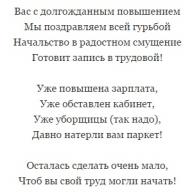Date in 2019: May 1st, Wednesday.
Traditionally, the beginning of May is perceived as a reason to relax. After all, it was this period that became a symbol of spring, a meeting of solar heat, a kind of start for work on the ground. And for Russians, this is also the beginning of the May holidays, when you can devote all your time to communicating with family or household chores. Many simply rest or celebrate Spring and Labor Day. But only a few can tell what history May Day has, and how the name and traditions of the holiday changed.
The very date of May 1 is perceived by Russians as a holiday. And many celebrate May Day with pleasure. Some, taking advantage of a legal weekend, go to nature or to a personal plot, and someone, remembering what a holiday on May 1 in Russia, gladly picks up the thematic symbols and goes to the May Day. And the most interesting thing is that each variant of the celebration is fully consistent with the theme of the holiday. Let's try to find out what historical events formed the basis of the holiday and what is the name of this day today in Russia.
Ancient history of the holiday
Many people associate the appearance of May Day with workers' strikes in Australia, America and Canada in the 19th century. But, as it turns out, the history of the May 1 holiday has more ancient roots.

And it is connected with the celebration of the goddess Maya in ancient Rome. This goddess patronized fertility, earth. And in her honor a beautiful holiday was organized, the purpose of which was to appease the goddess before working on the earth. The inhabitants of the ancient empire asked for their hard work to bring a well-deserved reward, and the land to give a good harvest. It was in honor of this goddess in the future that the last month of spring got its name - May.
This tradition of organizing mass festivities in honor of labor on the ground quickly spread to neighboring countries. But with the advent of Christianity, pagan customs began to be diligently supplanted by the church. And by the end of the 18th century, the folk customs of praising the "goddess of industriousness" were successfully eradicated. It became more popular, which became associated with revival, with spring.
The second birth of May Day
But the historical events that took place at the end of the 19th century gave the holiday a second life. It was revived, but already as a symbol of the solidarity of all working people.

Workers rally in Chicago
The history of the holiday in the sense in which it has come down to our days is associated with the liberation movement of American workers. They went on strike in 1886 under the leadership of socialist, communist, anarchist organizations. The event took place in Chicago, and according to some estimates, the number of demonstrators totaled up to 40,000.
Despite calls from more radical participants for a real socialist revolution, the purpose of this demonstration was to achieve human working conditions, and, above all, an 8-hour working day.
However, the payback for discontent was not long in coming. The demonstration was brutally dispersed by the police, and the very next day 1000 workers were simply out of work on the street. Such measures provoked a new wave of discontent, which has already had dire consequences. The shooting of demonstrators, the provocation with the detonation of the bomb, as a result of which the police themselves were killed, the execution of innocent workers could not change the hard labor conditions, but became the reason for the emergence of new protests and riots.
It was in honor of the first uprising that the tradition of celebrating May 1, the holiday of workers' solidarity, appeared later.
Literally three years after the historic event, May Day acquired the status of an international holiday. At the congress of the Second International, which was held in France, it was decided to support the Chicago workers. Support was expressed in the holding of rallies with social demands on May 1. And the holiday itself was named the World Day of Workers' Solidarity.
May Day in Russia
Russian workers did not stand aside from the international action. But, despite the recognition of the holiday at the state level, a certain time of May Day was held in a narrow circle and secretly. Already in 1901, open demonstrations took place, at which not so much social as political slogans appeared. They called for a change of government.

The beginning of May Day in Russia
And this seed of disobedience has borne fruit. In 1912, 400 thousand representatives of the proletariat attended the May meeting. And in 17, millions walked the streets.
When the Bolsheviks came to power, the celebration was already held openly, but acquired a different meaning. Moreover, the holiday became more ambitious, and its purpose was to glorify the existing ideology.
In every city, in every village, demonstrators marched along the streets with placards and banners, with flags and portraits of the people's leaders. And the most distinguished ones received the honorary opportunity to participate in the main parade of the country on Red Square.
Over time, the political overtones of May Day faded, and the opportunity to celebrate a holiday with family or friends came to the fore. Almost before the collapse of the Soviet Union, the tradition of holding processions was preserved, where congratulations were replaced by political speeches. But the second day, which was also a day off, was devoted to rest and communication.
So the political holiday gradually turned into a national one. But he kept his favorite attributes in the form of balls, red flags. People of the older generation recall with pleasure that feeling of elation, solemnity, which was accompanied by the feeling of the magic of spring. And I was even more pleased with the opportunity to relax, which became the main symbol of the beginning of May.
Modern traditions on May 1
The last solemn parade dedicated to the May Day took place in 1990. After the complete collapse of the Soviet Union, this tradition was lost. However, people continued to celebrate their favorite date with pleasure. Moreover, in the working calendar, spring days continued to be days off.

In 1992 the holiday got a new name. Now, May 1 is celebrated as a holiday of spring and labor. The idea of \u200b\u200buniting ancient and social traditions was accepted by the people without much jubilation. Indeed, for many, it is more important that the May holidays have survived, and not the very idea of \u200b\u200bthe holiday.
And in this form, the holiday embraced the customs of ancient ancestors, and the social orientation, and modern celebration trends.
On the first day of May, many are happy to go out not to demonstrations, but to their backyard or garden plots, and spend a holiday of workers, working on the land.
For others, it really is an excuse to rest. Therefore, many people try to spend the first spring picnic with family or friends on these days. They are full of varied and interesting offers for the May holidays and advertising brochures of travel agencies, which our compatriots use with pleasure to take a break from workdays.
But trade union, political organizations, social movements do not forget to go to May Day actions, but under their own slogans. They are joined by both like-minded people and absolutely apolitical citizens who just want to walk the streets out of habit with flags and balloons.

And although the holiday has lost its scale, it continues to delight people and unite workers. And the popular slogan of the Soviet era: “Peace! Work! May! ”- does not lose its relevance and sounds in almost all congratulations.
Congratulations

Please accept my congratulations on May Day. And let the most important day for all workers become simply the Day of Spring. May he give you hope, strength and inspiration. I wish you not to know fatigue and disappointment. May your work be only a joy, bring true pleasure and, of course, be appreciated. After all, only your favorite work can help you achieve unprecedented heights.
On May 1, all my wishes are associated with success, with high achievements, with labor "exploits". So remain an adherent of your favorite business, so that it brings not only pleasant fatigue and joy to the soul, but also real impressive rewards: respect for partners and competitors, the ability to bring the craziest ideas to life. Do not stop, just take a break so that after the holiday you will rush headlong into the whirlpool of new plans. And luck will always be with you - a diligent and purposeful worker.
Spring day, May Day,
Accept congratulations,
May all dreams come true
And also health and beauty.
Any troubles, let them forget the road to you,
But let luck always be with you.
And may the spring days bring happiness
And the warm breeze will drive away all your misfortunes.
Congratulations on the May Day mess,
With a song, shish kebabs across the neighboring river,
Congratulations to everyone on the work on earth,
The time for the Labor Day has already come.
Congratulations on the world, and even with difficulty,
With the noise of May outside your window
Congratulations just with kindness,
And, of course, with spring beauty.
And we have a holiday today,
The day spring came
We'll tease you now
You will be gifted.
I will come to congratulate you
I'm in a hurry with all my legs
After all, we have a kebab today,
And I will invite you.
Larisa, April 27, 2017.Russians are looking forward to the May holidays with special impatience - there are so many days off at the beginning of the month when the summer season opens! But if today every baby knows what May 9 is for Russia, then very few people can clearly tell what exactly we are celebrating on May 1. We are sorting out together with the IA "Amitel" about the May Day.
If you delve deeply into history, then even in antiquity, our ancestors arranged large-scale celebrations that fell on the end of April and the beginning of May. In this way they tried to appease the gods before starting to work in the fields. The Slavs celebrated the departure of the spring cold, arranged ritual bathing in cold water, burned fires, greeted the goddess I Live, who, according to legend, revived nature.
The inhabitants of Ancient Greece and Ancient Rome worshiped the goddess Maya, who was the patroness of farmers. In the last month of spring, in honor of the goddess and the beginning of a new harvest season, they held a big celebration.
Everyone probably remembers from history that two centuries ago a poor man's working day lasted from 12 to 15 hours. On April 21, 1856, workers' protest marches were held in Australia, which demanded that the working day be reduced to 8 hours and at the same time not reduce wages. They managed to get their way. And even without bloodshed
In 1886, workers in the United States and Canada also decided to organize rallies and demonstrations in order to achieve an 8-hour workday, a fixed wage and social security. On this day, every city revolted. However, the center of the protests was Chicago, where about 40,000 workers took to the streets. Here it was not possible to resolve the matter peacefully. Thousands of dismissals of workers followed, demonstrations were dispersed with weapons. A lot of people died. In memory of the victims, the Paris Congress of the Second International declared May 1, 1890, the Day of Solidarity of the Workers of the World and proposed to mark it with demonstrations demanding an 8-hour working day and other social requirements. The holiday has become an annual event.
How was May Day celebrated in Russia?

In the Russian Empire, May Day was first celebrated in 1890 in Warsaw. This tendency was picked up by St. Petersburg, where the May Day workers' strike took place in 1981 on May 1. In Moscow, the first May Day took place in 1895. Since 1897, May Day celebrations began to be political in nature and were accompanied by massive demonstrations. In 1917, May 1 was first celebrated openly. In all cities of the country, millions of workers took to the streets with the slogans of the Communist Party "All power to the Soviets", "Down with the capitalist ministers."
In 1918, in post-revolutionary Russia, a law was passed stating that May 1 will be celebrated at the national level.
In the USSR, the May Day demonstrations were of great importance. It was a really big celebration. Organizations have been preparing for it for weeks. In the first years of Soviet power, military equipment came out to the parade in honor of May 1, they staged real performances with acrobatic and gymnastic numbers. It was a real holiday that was expected.
It had many names. Initially, the USSR called May 1 the International Day. In 1930, this day was renamed the International Proletarian Solidarity Day. During the Great Patriotic War, it was named the Fighting Festival of the International Proletariat. After that, the official name appeared - International Labor Day. Since 1997, on May 1, we have been celebrating Spring and Labor Day.
Traditionally, the beginning of May is perceived as a reason to relax. Indeed, for Russians this is the beginning of the May holidays, including the Day of Spring and Labor. But not everyone can tell what history May Day has, and how the name and traditions of the holiday changed.
When did the tradition of celebrating May 1 appear?
If you delve into history, then even in antiquity, our ancestors organized large-scale celebrations, which fell on the end of April and the beginning of May. In this way they tried to appease the gods before starting to work in the fields. So, the inhabitants of Ancient Greece and Ancient Rome in the last spring month organized a big holiday in honor of the goddess Maya, who was the patroness of farmers.
The Slavs celebrated the departure of the cold spring and welcomed the goddess Zhiva, who, according to legend, had the power to revive nature. During the festivities, people would swim in cold water and burn ceremonial bonfires on the banks of rivers.
How is May Day related to workers?
Two centuries ago, a poor man's working day lasted from 12 to 15 hours, which naturally tired the people a lot. On April 21, 1856, workers' protest marches were held in Australia, which demanded that the working day be reduced to 8 hours and at the same time not reduce wages. They managed to get their way.
Successful strikes by Australians have inspired Americans to fight for their rights. On May 1, 1886, mass protests took place in many cities of the United States. The center of their protests was Chicago, where some 40,000 workers took to the streets to demand a reduction of the working day to 8 hours. The demonstrators were brutally dispersed by the police, and the very next day about 1,000 workers were left jobless in the street. Mass layoffs propelled the working class into a new wave of discontent. During the new demonstrations, many of the protesters were shot.
In memory of the victims, the Paris Congress of the Second International declared May 1, 1890, the Day of Solidarity of the Workers of the World and proposed to mark it with demonstrations demanding an 8-hour working day and other social demands. The holiday has become an annual event.
 Workers rally in Chicago
Workers rally in Chicago How was May 1 celebrated in Russia?
In the Russian Empire, May Day was first celebrated in 1890 in Warsaw. The following year, St. Petersburg celebrated the Day of Working People of the World, though underground. First opened on May 1, it was celebrated in Russia in 1917. In all cities of the country, millions of workers took to the streets with the slogans of the Communist Party "All power to the Soviets", "Down with the capitalist ministers."
In 1918, in post-revolutionary Russia, a law was passed stating that May 1 will be celebrated at the national level. Initially, this holiday was called the International Day. Since 1930, May 1 has been known as the International Proletarian Solidarity Day. During the Great Patriotic War, it was renamed the Fighting Day of the International Proletariat. Only after that did the official name appear - International Labor Day. Since 1997, on May 1, Russians have been celebrating Spring and Labor Day.
How is May 1 celebrated in modern Russia?
The tradition of holding demonstrations on this day has been preserved. The rallies are held by political parties and trade unions. Many people are happy to go to their summer cottages or garden plots on the first day of May, and spend a holiday of workers working on the land. People also often go out on May 1st for a picnic with family or friends.
Where else in the world is May 1 celebrated?
The first day of May is officially celebrated as a national holiday in more than 60 countries of the world. Including in Austria, France, China, Turkey, Belgium, etc. Some countries also have their own Labor Day, but celebrate it on a different day. For example, in the United States, it is celebrated on the first Monday in September.
The holiday, which is celebrated in Russia, the USA and a number of countries in Europe, Africa, Latin America and Asia on the first day of May, is known under several names at once - International Workers' Day, Spring and Labor Day, Labor Day, Spring Day. In Soviet times, most Russians named this holiday by the date of its holding - May 1 or May Day.
The emergence of the tradition of celebrating May Day is associated with the events that took place in Chicago in the 19th century. On May 1, 1886, large-scale rallies and demonstrations of workers began in the city, which demanded from their employers the introduction of an eight-hour working day.
The action ended in clashes with the police. On May 3, at Cyrus McCormick's reaper plant, police opened fire on strikers, killing at least two workers. On May 4, at a protest in Haymarket Square, a terrorist threw a bomb at police, who responded by firing at the crowd. Sixty police officers were injured, eight were killed, the exact number of workers killed was not determined. The police arrested hundreds of townspeople, and seven anarchist workers were sentenced to death.
In July 1889, the Paris Congress of the Second International, at the suggestion of the French delegate Raymond Lavigne, in solidarity with the Chicago workers, decided to hold annual workers' demonstrations on May 1.
On May 1, 1890, the holiday was first held in Austria-Hungary, Belgium, Germany, Denmark, Spain, Italy, USA, Norway, France and Sweden. In the UK, it took place on 4 May. The main slogan of the demonstrations was the demand for an eight-hour working day.
In 1891, by decision of the Brussels Congress of the Second International, the sections of the International in each country were given the right to independently set the date and form of celebration on May 1, after which in Great Britain and some other countries the demonstrations were postponed to the first Sunday in May.
On May 1, 1891, the Social Democratic group of revolutionary Mikhail Brusnev organized the first festive gathering of workers in Petrograd (now St. Petersburg).
May Day was celebrated as May Day - an illegal revolutionary meeting of workers, usually held outside the city.
The Kharkiv May Day, which took place in 1900, became the first open mass demonstration of workers in Russia, during which it was decided not to go to work and to organize a street demonstration.
Since that time, on May 1, demonstrations have taken place in various cities of Russia. During the First World War (1914-1918), performances on May 1 became sporadic.
Spring and Labor Day for social and labor justice, festivities and concerts.
The material was prepared on the basis of information from RIA Novosti and open sources
Labor Day is celebrated in many cities around the world on May 1. This holiday is celebrated in memory of the workers' struggle for their rights in the late 19th and early 20th centuries.
history of the holiday
In the middle of the 19th century, with the growth of production, more and more people in industrialized countries (Europe, USA, Russia, etc.) left the village and moved to the city, where they got a job in factories and plants. The working day of workers, minus three breaks for eating (1 hour for lunch and 20-30 minutes for breakfast and dinner) lasted 12-15 hours. The usual weekend for us - Saturday and Sunday - was not.
"May Day" poster. Artist Vasily Vasilyevich Suryaninov. Reproduction. Photo: RIA Novosti / V. Shiyanovsky
Hard physical labor was paid little, workers lacked food and lived in conditions that did not meet sanitary and hygienic requirements. In most cases, their homes were overcrowded. Cheap child labor is widespread.
All this led to an aggravation of the social situation. Workers began to unite in trade unions and organize strikes, demanding higher wages, an eight-hour working day and other improvements in working conditions. At the same time, socialist and communist, as well as anarchist ideas began to spread among them. The most radical proponents of these ideas called for a social revolution - the establishment of workers' power.
On May 1, 1886, Chicago (USA) held a peaceful demonstration of workers demanding an eight-hour working day. The rally was violently dispersed by the police and four demonstrators were killed. In the evening of the same day, provocateurs threw a bomb at a police detachment. The police opened fire on the crowd. The explosion and shootout killed ten people and injured dozens.
Four anarchist workers were executed on charges of organizing the terrorist attack. Although the guilt of the convicts has not been proven.
In memory of these tragic events, in the summer of 1889, the Paris Congress of the Second International declared May 1 as Workers' Solidarity Day and proposed annually celebrating it with demonstrations around the world. For the first time, May 1 was celebrated in 1890 by the workers of Belgium, France, Germany, USA, Denmark, Spain and some other countries.
When did they start celebrating May 1 in Russia?

May Day demonstration in Pskov. 1917 year. Photo: Commons.wikimedia.org / sharphead's archive








